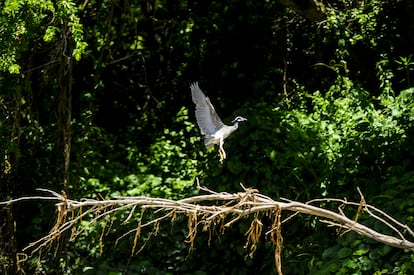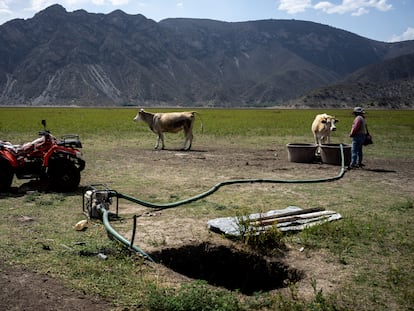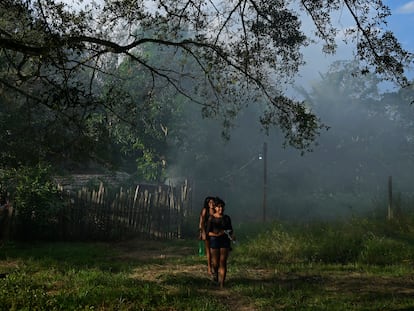Birds are also threatened by drug trafficking in Central America
Illegal trade is endangering two-thirds of key habitats for 196 species. A new study explains how prohibitionist policies lead to deforestation


The relationship been drug trafficking and deforestation in Central America has been heavily studied. Whether through the construction of illegal roads to move cargo, the clearing of forest to erect waystations or the expansion of cattle ranches suitable for money laundering and the control of territories, the presence of the drug trade in the region has left scars on its lands. Studies indicate that between 15% and 30% of deforestation in Nicaragua, Honduras and Guatemala can be attributed to cocaine trafficking alone.
But the risk is even greater than previously believed. According to an article published by Nature Sustainability, birds that live in or migrate to the forests of Central America are also being affected by international anti-drug campaigns, putting their conservation at risk. According to the publication, two-thirds of the key habitats for forest-based birds in the region are at risk from such policies, and more than half of the migratory species that pass through the region are at risk of losing more than a quarter of their populations in areas threatened by drug trafficking.
“We were quite surprised by the spatial overlap that exists between landscapes that are important for birds and areas expected to become more conducive to drug trafficking,” says professor Amanda Rodewald, director of the Center for Avian Population Studies at the Cornell University Lab of Orinthology and co-author of the study, on a phone call with EL PAÍS. “Because we leveraged two existing data sets, we were able, for the first time, to learn how vulnerable some of these forest birds, whether resident or migratory, are to the movements of the narcos.”
What the expert is referring to is that, in order to find this not-so-evident relationship, her team superimposed two layers of data. The first was from a previous study, carried out by one of the study’s other co-authors, geographer Nicholas Magliocca of the University of Alabama, which tracked which areas were most attractive to drug traffickers and where they would elect to move after being interrupted by anti-drug policing. “Here it is important to clarify that this data is not about drug cultivation, but about their trafficking routes. The likelihood of an area being chosen takes place through the lens of drug trafficking, and not from the perspective of earth sciences or ecology,” Rodewald points out.
Once that initial mapping had been done, it was cross-referenced with information from the EBird database, a global platform onto which scientists, as well as other citizens, upload their bird sightings. This allows for the precise registration of each species’ habitat. The countries studied were Costa Rica, El Salvador, Guatemala, Honduras, Nicaragua and Panama, putting particular emphasis on the anti-drug operations that were carried out between 2007 and 2018, and identifying 196 species of birds that at one point lived in this area, whether they were residents or migrants.

This is how researchers were able to find that one out of every five species that migrate to Central America in the winter have more than half of their population located in areas that have become more attractive to drug traffickers following a spike in police crackdowns designed to seize cocaine. For species such as the federally endangered golden-cheeked warbler (Dendroica chrysoparia), the federally endangered golden-winged warbler (Vermivora chrysoptera) and the Philadelphia vireo (Vireo philadelphicus), the figure rises to 90% and 70%, respectively.
“The primary message of our study is that we cannot address social problems like drug trafficking in a vacuum, because it can have unintended environmental consequences,” explains Rodewald. “Current drug policy strategies, largely driven by the United States, focus on the supply side, interdicting traffickers. By doing this, what is being created is a dynamic that is pushing them into increasingly remote and highly important forest areas for both species conservation and Indigenous populations.”
Therefore, the study emphasizes that other, more local policies are needed, such as strengthening institutions that monitor deforestation and guaranteeing land rights to Indigenous and rural communities. Attacking illegal drug routes for 40 years has not proven sufficient in stopping the illegal drug trade and has instead pushed deforestation. In addition, the research indicates that such prohibitionist policies endanger birds that migrate to or reside in Central American forests. Many of these are part of the five big forests of Mesoamerica, including the Moskitia in Nicaragua and Honduras, the Indio Maíz-Tortuguero in Nicaragua and Costa Rica, and the Talamanca region in Costa Rica and Panama.
“This intersection between social issues, human health, well-being and biodiversity conservation is coming increasingly into focus,” Rodewald concludes. “It is something that is explored by the Kunming-Montreal Global Biodiversity Framework and that will be continued to be discussed in Cali.” Talks will continue at the COP16 on biodiversity that will be held in Colombia, a country that has undoubtedly experienced the relationship between drug trafficking, nature and human life at the deepest, most painful level.
Sign up for our weekly newsletter to get more English-language news coverage from EL PAÍS USA Edition
Tu suscripción se está usando en otro dispositivo
¿Quieres añadir otro usuario a tu suscripción?
Si continúas leyendo en este dispositivo, no se podrá leer en el otro.
FlechaTu suscripción se está usando en otro dispositivo y solo puedes acceder a EL PAÍS desde un dispositivo a la vez.
Si quieres compartir tu cuenta, cambia tu suscripción a la modalidad Premium, así podrás añadir otro usuario. Cada uno accederá con su propia cuenta de email, lo que os permitirá personalizar vuestra experiencia en EL PAÍS.
¿Tienes una suscripción de empresa? Accede aquí para contratar más cuentas.
En el caso de no saber quién está usando tu cuenta, te recomendamos cambiar tu contraseña aquí.
Si decides continuar compartiendo tu cuenta, este mensaje se mostrará en tu dispositivo y en el de la otra persona que está usando tu cuenta de forma indefinida, afectando a tu experiencia de lectura. Puedes consultar aquí los términos y condiciones de la suscripción digital.
More information
Archived In
Últimas noticias
Raúl Rocha, from jet-setting with Miss Universe to arms trafficking and fuel theft
80,000 barrels of Mexican oil sent to Cuba: Havana drawn into the US–Mexico clash
Human rights activists, opposition members, and a minor: Maduro’s other political prisoners
Israel sparks a civil war within the MAGA movement
Most viewed
- Reinhard Genzel, Nobel laureate in physics: ‘One-minute videos will never give you the truth’
- Pablo Escobar’s hippos: A serious environmental problem, 40 years on
- Charles Dubouloz, mountaineering star, retires at 36 with a farewell tour inspired by Walter Bonatti
- Why we lost the habit of sleeping in two segments and how that changed our sense of time
- The fall of a prolific science journal exposes the billion-dollar profits of scientific publishing










































